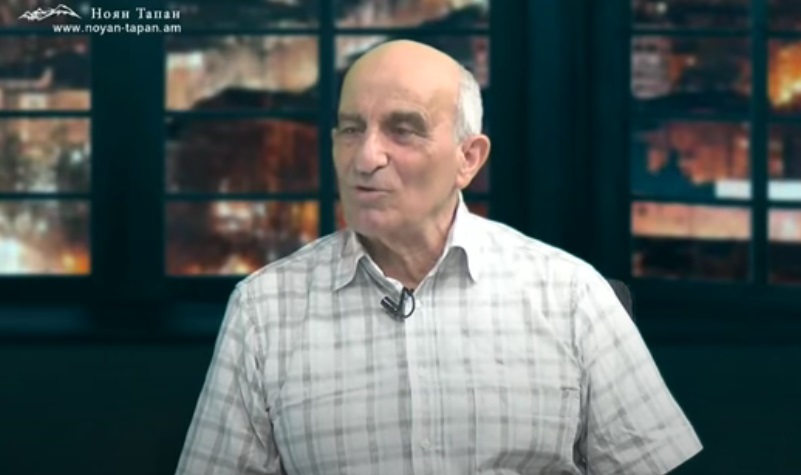in Russian – https://aga-tribunal.info/a-manasyan-2-11-2021/
A report by Alexandr Manasyan at the international online conference “UN responsibility for the protection of the cultural heritage of ancient peoples from cultural genocide”, held in Saint Petersburg on November 2-3, 2001. About conference – https://aga-tribunal.info/conf-2-11-2021-en/ Translation from Russian by AGA-Tribunal.info.
The topic of cultural genocide is multifaceted. An important direction in the fight against this modern manifestation of barbarism is the certification of monuments and objects of cultural heritage and their presentation to the world community. But it is important not to forget that this problem is cultural, political, psychological and even philosophical. These aspects of the problem need to be comprehended in order to answer our opponents from Baku. I have submitted for publication in a journal a new article “The state in real international criminal acts. Methodological flaws in the study of the topic by the UN international law Commission”. It turns out that in the highest political circles there are being developed positions that turn out to be not only, say, anti-Armenian, but simply dangerous for all of humanity. I am not afraid of these words. The history of the introduction of the Nuremberg principles into international law is a direct evidence of this.
Video (9 min, in Russian)
As known, after World War II, the task was to implement the principles of Nuremberg into international law. On this occasion are known Truman’s pompously spoken words about the need to implement the Nuremberg principles into international law so that the tragedy of World War II does not repeat itself[1]. However, later it turned out that gradually, in a not very noticeable way, all this evolved in the direction of departure from the original principle. Initially, it was believed that states should be held accountable for crimes, as possible subjects of criminal acts. Until 1996, when the UN General Assembly adopted the “Draft Code of Crimes against the Peace and Security of Mankind” (UN Doc. A / 51/10)[2], this point of view prevailed and it seemed that soon we would receive a document recognizing the place of the state in the realities of international crimes. But this did not happen. In 1997, instead of the Special Rapporteur G. Arangio-Ruiz (Italy), J. Crawford (Australia) was appointed[3], and when he joined the International Law Commission (“ILC”), which involved major jurists from different countries, everything gradually began to change. Already in 2001, on the basis of a document submitted by the Committee, the UN General Assembly adopted Resolution 56/83 “Responsibility of States for Internationally Wrongful Acts”[4]. Such concepts as punishment for crimes, for criminal acts of the state were removed. All this was removed from the document. There was even talk of limiting ourselves to voting without adopting a Convention.
It is important to analyze this document, adopted first in the said Sixth Committee, and then at the UN General Assembly in 2001. James Crawford’s own words are noteworthy: that the majority of states were in favor of the state being a subject of jurisdiction in the event of internationally wrongful acts. At the same time, he added that “a significant number” of states were against. As a result, the “significant number” outweighed the majority. So, it was possible to turn the tide in the UN Sixth Committee. Before that day the previous Special Rapporteur, G. Arangio-Ruiz said that aggression as a crime can only be committed by the state and that one cannot retreat from it. However, this was not done. The document, which was adopted in 2001, has remained to this day with numerous flaws. Flaws in international law enable Azerbaijan not only to commit acts of genocide and criminal acts against humanity, but also to hide behind, defend itself, and be covered by international law. The document we spoke about admits this, and it was created at the highest level of lawmaking in the UN Sixth Committee, probably under pressure, as J. Crawford admits, “a significant number of states” over the opinion of most states.
Therefore, we must also participate at this highest level in these processes and know by name who is fighting for what in the world, especially in this field. We are able and should do this in parallel with what was said at this conference – with regard to facts, documentation on the objects of cultural heritage, inventory, etc. All this must be done with bringing the facts to international circles. But it is also necessary to participate in the processes (or at least to be aware of the processes) in this important area, where the “positions of international circles” are developed and key documents are adopted on topics related to crimes against humanity.
[1] “On 12 November 1946, in a letter written in reply to a report by Judge Biddle, United States member of the Nürnberg Tribunal, President Truman expressed “[the] hope that the United Nations will reaffirm the principles of the Nürnberg Charter in the context of a general codification of offenses against the peace and security of mankind,” General Assembly Resolution 95(I), December 11, 1946 (page 1) https://legal.un.org/avl/pdf/ha/ga_95-I/ga_95-I_ph_e.pdf
[2] https://legal.un.org/ilc/texts/instruments/english/draft_articles/7_4_1996.pdf
[3] https://legal.un.org/avl/pdf/ha/rsiwa/rsiwa_e.pdf
[4] https://legal.un.org/ilc/texts/instruments/english/draft_articles/9_6_2001.pdf
